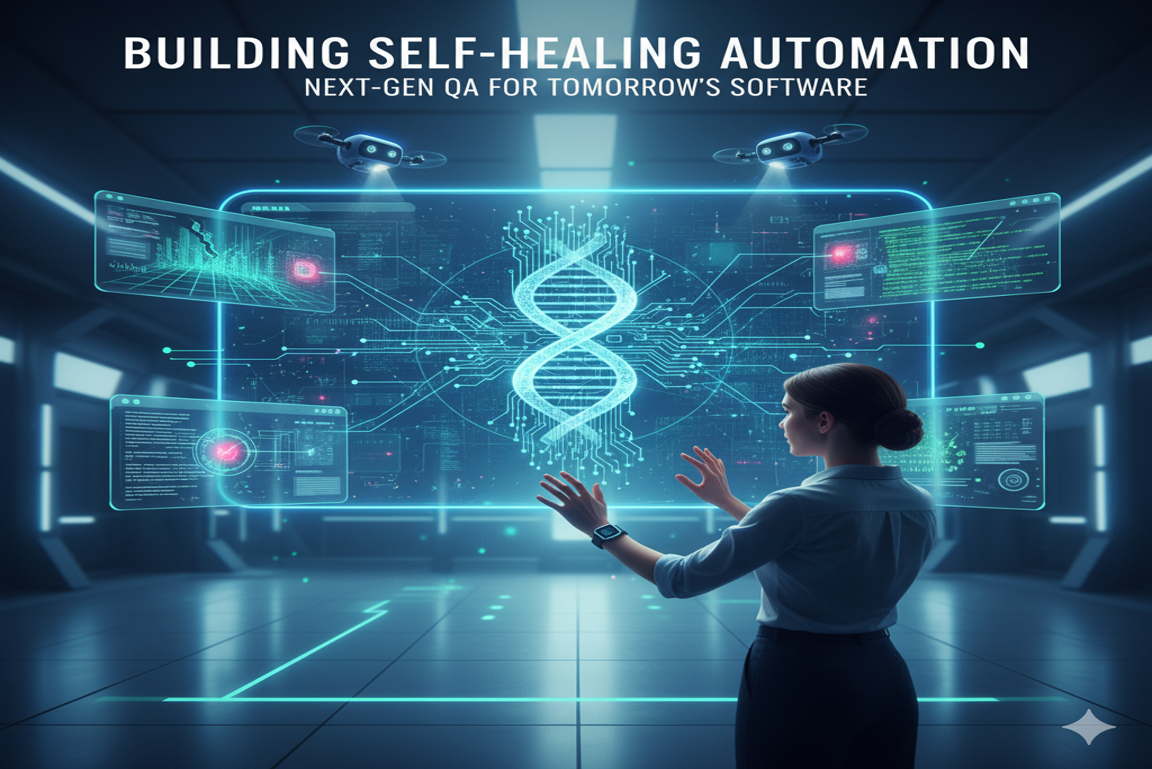
How a BDE Connects Business Vision With Technology
How a BDE Connects Business Vision With Technology Kumkum Kumari 21/11/2025At Speqto, we work with organizations that are constantly evolving entering new markets, scaling operations, or […]


Traditional automated testing faces a critical challenge: constant application changes break scripts, overwhelm QA teams, and turn continuous testing into a nightmare of endless fixes. The answer? Self-healing automation—a breakthrough approach leveraging AI and machine learning to automatically adapt and repair broken tests in real-time, slashing maintenance efforts and transforming quality assurance into a proactive, resilient force for tomorrow’s software.
In this blog, discover how self-healing automation not only sustains test coverage through continuous delivery but also empowers QA teams to focus on higher-value tasks. Explore the powerful strategies, practical examples, and next-gen tools redefining how modern organizations achieve reliable, scalable software testing.
With CI/CD pipelines and daily code changes now the norm, the biggest bottleneck in QA is keeping tests up-to-date. Studies show teams spend up to 70% of their effort just maintaining automated tests, which defeats their purpose. Self-healing automation reverses this—with AI systems identifying, diagnosing, and fixing broken tests instantly, QA teams regain productivity and ensure truly continuous testing without constant patchwork.
Modern self-healing frameworks continuously monitor application elements (like XPaths, CSS selectors, labels), learning patterns, and storing a “fingerprint” of each target element. When a locator fails—say, a button ID changes or an element moves—the system searches for alternative attributes, applies fuzzy matching, and leverages past healing data. The test script is auto-corrected and resumes execution without human intervention.
Key Mechanisms:
Example: A payment button labelled confirmButton becomes purchaseConfirmButton after a new release. Traditional tests fail. Self-healing automation matches context, updates the locator automatically, and the test passes without disruption. Dynamic Waits: Self-healing frameworks adjust wait times based on element readiness, preventing failures due to timing issues.
API Testing: Self-healing modifies verification logic for API responses and structures, instantly adapting to schema updates.
Object Repository Healing: Automated frameworks maintain multiple locators per element, switching seamlessly if primary keys break.
Full Pipeline Integration: Self-healing is embedded into CI/CD flows, supporting zero-touch deployments and rollback on detection of genuine failures.
Self-healing automation delivers the long-awaited promise of truly continuous testing. By combining intelligent, proactive adaptation with the rigor of human oversight, QA teams will drive software quality higher than ever before—unburdened by endless fixes, empowered to focus on innovation, and ready for the rapidly evolving demands of tomorrow’s software landscape.
Q: Will self-healing automation replace QA engineers?
A: No—self-healing tools empower QA professionals, reducing repetitive maintenance while freeing time for in-depth, creative testing.
Q: What tools enable self-healing automation?
A: DogQ, Virtuoso, Selenium with AI plugins, and modern AI-powered frameworks lead the space for self-healing functionality.
Q: Are there risks to automated healing?
A: While powerful, healing can mask real defects. Always review critical flows and pair automation with human judgment.
Explore our guides on AI-Powered Testing and DevOps for QA Automation to further future-proof your quality assurance strategy.
Ready to build a future-proof QA strategy? Partner with Speqto’s automation experts to design resilient, self-healing test suites for your projects. Contact our consulting team today for a free consultation.

How a BDE Connects Business Vision With Technology
How a BDE Connects Business Vision With Technology Kumkum Kumari 21/11/2025At Speqto, we work with organizations that are constantly evolving entering new markets, scaling operations, or […]

Apache JMeter Demystified: Your 7-Stage Blueprint for a Seamless First Performance Test
Apache JMeter Demystified: Your 7-Stage Blueprint for a Seamless First Performance Test Megha Srivastava 21 November 2025 In the intricate world of software development and deployment, ensuring a robust user experience is paramount. A slow application can quickly deter users, impacting reputation and revenue. This is where Apache JMeter emerges as an indispensable tool, offering […]

STRIDE Simplified: A Hands-On Blueprint for Pinpointing Software Threats Effectively
STRIDE Simplified: A Hands-On Blueprint for Pinpointing Software Threats Effectively Megha Srivastava 21 November 2025 In the intricate landscape of modern software development, proactive security measures are paramount. While reactive incident response is crucial, preventing vulnerabilities before they become exploits is the hallmark of robust software engineering. This is where threat modeling, and specifically the […]

From Static to Streaming: A Practical Developer’s Guide to Real-time Applications Using GraphQL Subscriptions
From Static to Streaming: A Practical Developer’s Guide to Real-time Applications Using GraphQL Subscriptions Shakir Khan 21 November 2025 The Paradigm Shift: From Static to Streaming Experiences In an era where user expectations demand instant gratification, the web has rapidly evolved beyond its static origins. Today, a modern application’s success is often measured by its […]

The TanStack Query Edge: Deep Dive into Advanced Caching for Optimal Application Speed
The TanStack Query Edge: Deep Dive into Advanced Caching for Optimal Application Speed Shubham Anand 21 November 2025 In the relentless pursuit of seamless user experiences and lightning-fast web applications, data management stands as a formidable challenge. Modern front-end frameworks demand intelligent solutions to handle asynchronous data, and this is precisely where TanStack Query (formerly […]